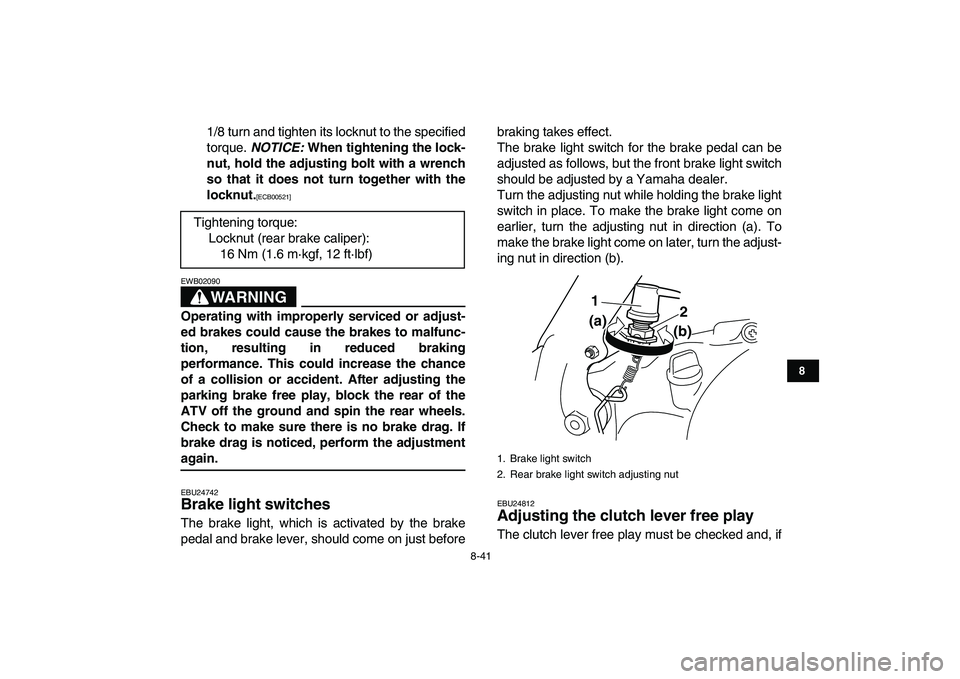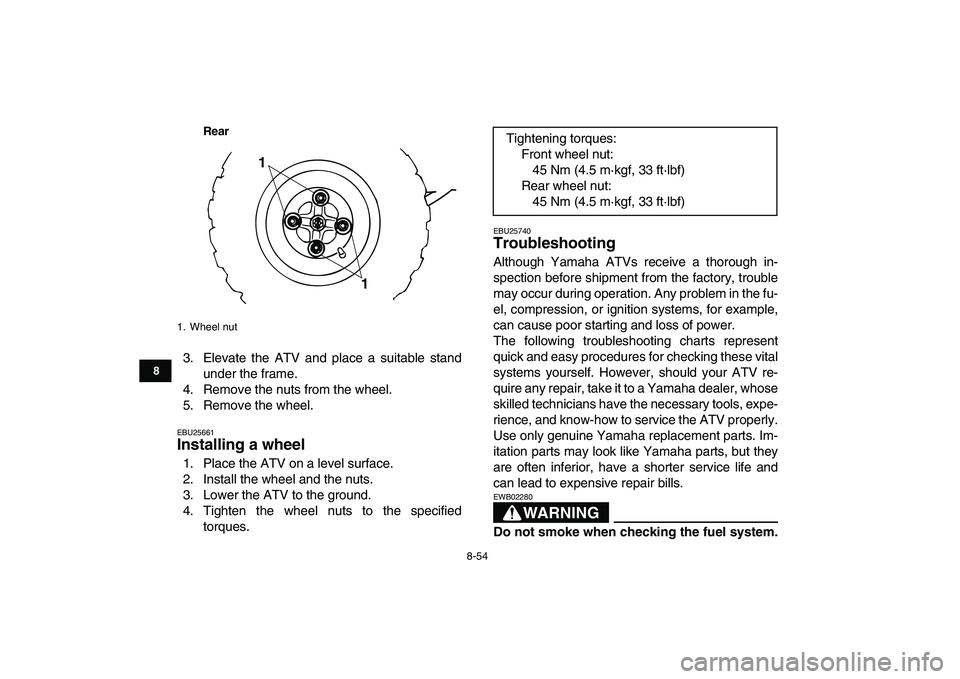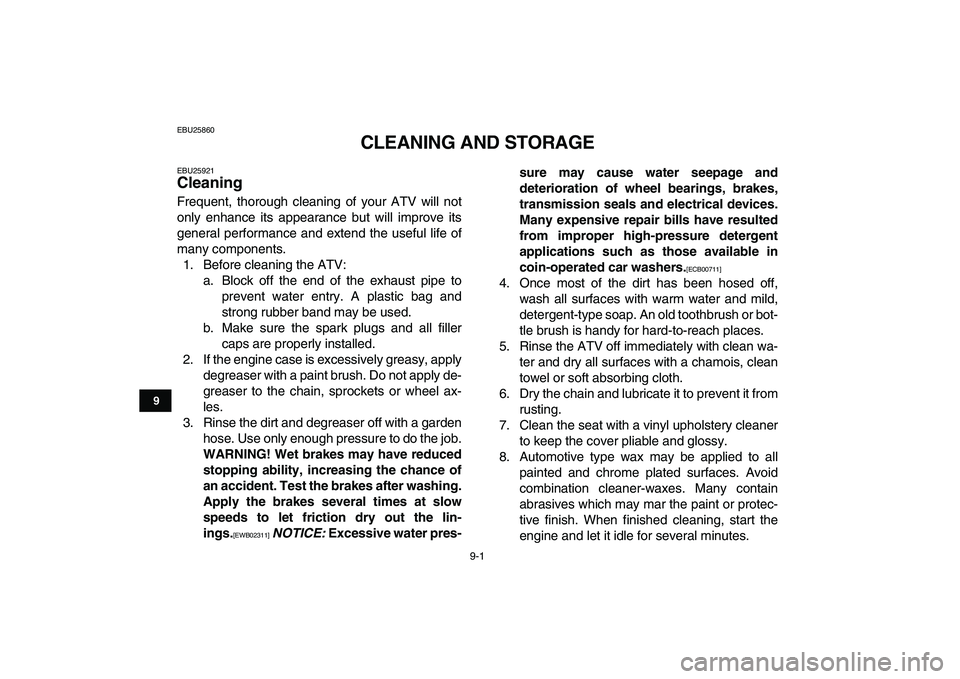Page 113 of 148
8-35
1
2
3
4
5
6
78
9
10
11
WARNING
EWB02571
Operating with improperly serviced or adjust-
ed brakes could lead to a loss in braking ability
and an accident.
EBU29821
Checking the front and rear brake pads
The front and rear brake pads must be checked for
wear at the intervals specified in the periodic main-
tenance and lubrication chart. Each brake pad is
provided with two wear indicator grooves, which al-
low you to check the brake pad wear without hav-
ing to disassemble the brake. To check the brake
pad wear, check the wear indicator grooves. If a
brake pad has worn to the point that a wear indica-
tor groove almost appears, have a Yamaha dealer
replace the brake pads as a set.
TIP
The wheels need to be removed to check the
brake pads. (See page 8-53.)
Front brake
1. Wear indicator groove
1
Page 119 of 148

8-41
1
2
3
4
5
6
78
9
10
11
1/8 turn and tighten its locknut to the specified
torque.
NOTICE:
When tightening the lock-
nut, hold the adjusting bolt with a wrench
so that it does not turn together with the
locknut.
[ECB00521]
WARNING
EWB02090
Operating with improperly serviced or adjust-
ed brakes could cause the brakes to malfunc-
tion, resulting in reduced braking
performance. This could increase the chance
of a collision or accident. After adjusting the
parking brake free play, block the rear of the
ATV off the ground and spin the rear wheels.
Check to make sure there is no brake drag. If
brake drag is noticed, perform the adjustment
again.
EBU24742
Brake light switches
The brake light, which is activated by the brake
pedal and brake lever, should come on just beforebraking takes effect.
The brake light switch for the brake pedal can be
adjusted as follows, but the front brake light switch
should be adjusted by a Yamaha dealer.
Turn the adjusting nut while holding the brake light
switch in place. To make the brake light come on
earlier, turn the adjusting nut in direction (a). To
make the brake light come on later, turn the adjust-
ing nut in direction (b).
EBU24812
Adjusting the clutch lever free play
The clutch lever free play must be checked and, if Tightening torque:
Locknut (rear brake caliper):
16 Nm (1.6 m·kgf, 12 ft·lbf)
1. Brake light switch
2. Rear brake light switch adjusting nut
1
2
(a)
(b)
Page 122 of 148
8-44
1
2
3
4
5
6
78
9
10
11
3. Loosen the locknut on each side of the swing-
arm. To tighten the drive chain, turn the ad-
justing bolts in direction (a). To loosen the
drive chain, turn the adjusting bolts in direction
(b) and push the wheels forward. Turn each
adjusting bolt exactly the same amount to
maintain correct axle alignment.
NOTICE:
Im-
proper drive chain slack will overload the
engine as well as other vital parts of the
ATV and can lead to drive chain slippage
or breakage. To prevent this from occur-
ring, keep the drive chain slack within thespecified limits.
[ECB00542]
TIP
There are alignment marks on each side of the
swingarm and on the wheel hubs. Use them to
check for proper wheel axle alignment.
4. Tighten the locknuts and the axle holding nuts
to the specified torques.
1. Axle holding nut (upper)
2. Axle holding nut (lower)
1
2
1. Drive chain slack adjusting bolt
2. Locknut
3. Alignment marks
3
12(a)
(b)
Page 125 of 148
8-47
1
2
3
4
5
6
78
9
10
11
EBU24963
Checking the wheel hub bearings
The front and rear wheel hub bearings must be
checked at the intervals specified in the periodic
maintenance and lubrication chart. If there is play
in a wheel hub or if a wheel does not turn smoothly,
have a Yamaha dealer check the wheel hub bear-
ings.
EBU25004
Lubricating the rear suspension relay
arm and connecting arm pivoting
points
The rear suspension relay arm and connecting
arm pivoting points must be lubricated at the inter-
vals specified in the periodic maintenance and lu-brication chart.
TIP
For parts equipped with a grease nipple, use a
grease gun.
Recommended lubricant:
Lithium-soap-based grease
1. Grease nipple
1
Page 131 of 148
8-53
1
2
3
4
5
6
78
9
10
11
3. Insert a new bulb into the bulb holder, push it
in, and then turn it clockwise until it stops.
4. Install the bulb holder (together with the bulb)
by turning it clockwise.
EBU25651
Removing a wheel
1. Place the ATV on a level surface.
2. Loosen the wheel nuts.
Front
1. Tail/brake light bulb holder
2. Tail/brake light bulb
1
2
1. Wheel nut
1
1
Page 132 of 148

8-54
1
2
3
4
5
6
78
9
10
11
Rear
3. Elevate the ATV and place a suitable stand
under the frame.
4. Remove the nuts from the wheel.
5. Remove the wheel.
EBU25661
Installing a wheel
1. Place the ATV on a level surface.
2. Install the wheel and the nuts.
3. Lower the ATV to the ground.
4. Tighten the wheel nuts to the specified
torques.
EBU25740
Troubleshooting
Although Yamaha ATVs receive a thorough in-
spection before shipment from the factory, trouble
may occur during operation. Any problem in the fu-
el, compression, or ignition systems, for example,
can cause poor starting and loss of power.
The following troubleshooting charts represent
quick and easy procedures for checking these vital
systems yourself. However, should your ATV re-
quire any repair, take it to a Yamaha dealer, whose
skilled technicians have the necessary tools, expe-
rience, and know-how to service the ATV properly.
Use only genuine Yamaha replacement parts. Im-
itation parts may look like Yamaha parts, but they
are often inferior, have a shorter service life and
can lead to expensive repair bills.WARNING
EWB02280
Do not smoke when checking the fuel system.
1. Wheel nut
1
1
Tightening torques:
Front wheel nut:
45 Nm (4.5 m·kgf, 33 ft·lbf)
Rear wheel nut:
45 Nm (4.5 m·kgf, 33 ft·lbf)
Page 136 of 148

9-1
1
2
3
4
5
6
7
89
10
11
EBU25860
CLEANING AND STORAGE
EBU25921
Cleaning
Frequent, thorough cleaning of your ATV will not
only enhance its appearance but will improve its
general performance and extend the useful life of
many components.
1. Before cleaning the ATV:
a. Block off the end of the exhaust pipe to
prevent water entry. A plastic bag and
strong rubber band may be used.
b. Make sure the spark plugs and all filler
caps are properly installed.
2. If the engine case is excessively greasy, apply
degreaser with a paint brush. Do not apply de-
greaser to the chain, sprockets or wheel ax-
les.
3. Rinse the dirt and degreaser off with a garden
hose. Use only enough pressure to do the job.
WARNING! Wet brakes may have reduced
stopping ability, increasing the chance of
an accident. Test the brakes after washing.
Apply the brakes several times at slow
speeds to let friction dry out the lin-
ings.
[EWB02311]
NOTICE:
Excessive water pres-sure may cause water seepage and
deterioration of wheel bearings, brakes,
transmission seals and electrical devices.
Many expensive repair bills have resulted
from improper high-pressure detergent
applications such as those available in
coin-operated car washers.
[ECB00711]
4. Once most of the dirt has been hosed off,
wash all surfaces with warm water and mild,
detergent-type soap. An old toothbrush or bot-
tle brush is handy for hard-to-reach places.
5. Rinse the ATV off immediately with clean wa-
ter and dry all surfaces with a chamois, clean
towel or soft absorbing cloth.
6. Dry the chain and lubricate it to prevent it from
rusting.
7. Clean the seat with a vinyl upholstery cleaner
to keep the cover pliable and glossy.
8. Automotive type wax may be applied to all
painted and chrome plated surfaces. Avoid
combination cleaner-waxes. Many contain
abrasives which may mar the paint or protec-
tive finish. When finished cleaning, start the
engine and let it idle for several minutes.
Page 137 of 148

9-2
1
2
3
4
5
6
7
89
10
11
EBU25952
Storage
Short-term
Always store your ATV in a cool, dry place and, if
necessary, protect it against dust with a porous
cover.
NOTICE:
Storing the ATV in a poorly ven-
tilated room or covering it with a tarp while it is
still wet, will allow water and humidity to seep
in and cause rust. To prevent corrosion, avoid
damp cellars, stables (because of the presence
of ammonia) and areas where strong chemi-
cals are stored.
[ECB00721]
Long-term
Before storing your ATV for several months:
1. Follow all the instructions in the “Cleaning”
section of this chapter.
2. Turn the fuel cock lever to “OFF”.
3. Drain the carburetor float chamber by loosen-
ing the drain bolt; this will prevent fuel deposits
from building up. Pour the drained fuel into the
fuel tank.
4. Fill up the fuel tank and add fuel stabilizer (if
available) to prevent the fuel from deteriorat-
ing.5. Perform the following steps to protect the cyl-
inders, piston rings, etc. from corrosion.
a. Remove the spark plug caps and spark
plugs.
b. Pour a teaspoonful of engine oil into each
spark plug bore.
c. Install the spark plug caps onto the spark
plugs, and then place the spark plugs on
the cylinder head so that the electrodes
are grounded. (This will limit sparking dur-
ing the next step.)
d. Turn the engine over several times with
the starter. (This will coat the cylinder walls
with oil.)
e. Remove the spark plug caps from the
spark plugs, and then install the spark
plugs and the spark plug caps.
6. Lubricate all control cables and the pivoting
points of all levers and pedals.
7. Check and, if necessary, correct the tire air
pressure, and then block up the ATV so that
all of its wheels are off the ground. Alternative- Specified amount:
7.5 ml of stabilizer to each liter of fuel (or 1 oz
of stabilizer to each gallon of fuel)